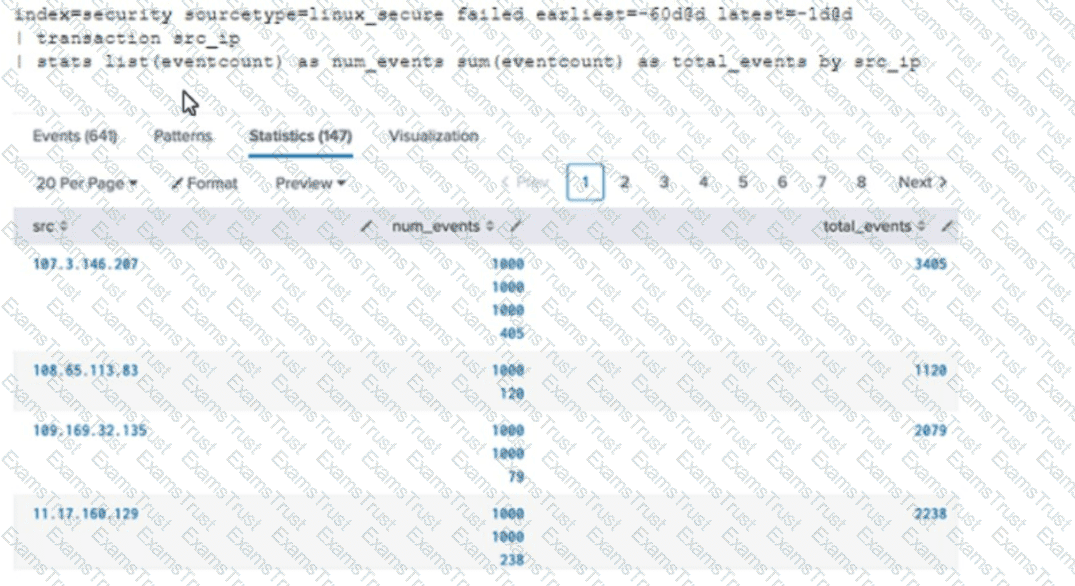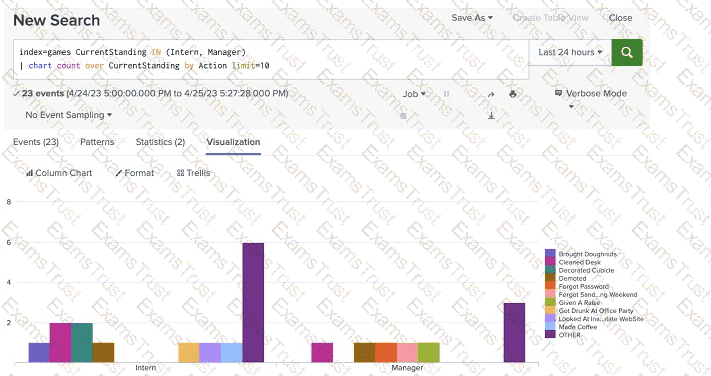Which command is used to create choropleth maps?
Which of the following data models are included in the Splunk Common Information Model (CIM) add-on? (select all that apply)
What does the fillnull command do in this search?
index=main sourcetype=http:log | fillnull value="Unknown"
When performing a regex field extraction with the Field Extractor (FX), a data type must be chosen before a sample event can be selected. Which of the following data types are supported?
When using transaction, what is the default maximum span between events?
Which of the following statements is true, especially in large environments?
What information must be included when using the datamodel command?
Why would the following search produce multiple transactions instead of one?

Which of the following searches would create a graph similar to the one below?

Which of the following actions can the eval command perform?
What fields does the transaction command add to the raw events? (select all that apply)
What is the purpose of a calculated field?
Given the following eval statement:
... | eval field1 = if(isnotnull(field1),field1,0), field2 = if(isnull(field2), "NO-VALUE", field2)
Which of the following is the equivalent using fillnull?
Given the event below, how can the value in the Zip_Code field be used to retrieve the weather from an external resource?
25/Oct/2023:20:29:43
151.162.101.143, v2.003, Zip_Code: 75510, DataCenter: DC1
Which of the following statements describes field aliases?
Data model fields can be added using the Auto-Extracted method. Which of the following statements describe Auto-Extracted fields? (select all that apply)
How are event types different from saved reports?
Which of the following statements describes this search?
sourcetype=access_combined I transaction JSESSIONID | timechart avg (duration)
When should you use the transaction command instead of the scats command?
The transaction command allows you to __________ events across multiple sources
Which of the following statements describes the use of the Filed Extractor (FX)?
For the following search, which command would further filter for only IP addresses present more than five times?
Which function should you use with the transaction command to set the maximum total time between the earliest and latest events returned?
Which of the following commands will show the maximum bytes?
Which workflow uses field values to perform a secondary search?
Which is not a comparison operator in Splunk
Where are the results of eval commands stored?
Splunk alerts can be based on search that run______. (Select all that apply.)
What commands can be used to group events from one or more data sources?
Which of the following searches will show the number of categoryld used by each host?
Which search string would only return results for an event type called success ful_purchases?
This clause is used to group the output of a stats command by a specific name.
A Splunk app is configured to extract domain names in web service logs and specify them as a field named domain.
What workflow action would return an external IP lookup for the field named domain?
How could the following syntax for the chart command be rewritten to remove the OTHER category? (select all that apply)

The timechart command is an example of which of the following command types?
Which of the following search modes automatically returns all extracted fields in the fields sidebar?
The Common Information Model (CIM) Add-on contains a collection of what preconfigured knowledge objects?
Consider the following search:
index=web sourcetype=access_corabined
The log shows several events that share the same jsesszonid value (SD462K101O2F267). View the events as a group.
From the following list, which search groups events by jSSESSIONID?
The gauge command:
Which of the following Statements about macros is true? (select all that apply)
Which syntax is used to represent an argument in a macro definition?
Which of the following is one of the pre-configured data models included in the Splunk Common Information Model (CIM) add-on?
Use this command to use lookup fields in a search and see the lookup fields in the field sidebar.
In what order arc the following knowledge objects/configurations applied?
What is the Splunk Common Information Model (CIM)?
Which of the following statements about tags is true? (select all that apply.)
Which of the following statements is true about the root dataset of a data model?
Which of the following can be saved as an event type?
Clicking a SEGMENT on a chart, ________.
What is a limitation of searches generated by workflow actions?
Data model are composed of one or more of which of the following datasets? (select all that apply.)
What happens when a user edits the regular expression (regex) field extraction generated in the Field Extractor (FX)?
Which of the following searches can be used to define an event type?
In the following eval statement, what is the value of description if the status is 503? index=main | eval description=case(status==200, "OK", status==404, "Not found", status==500, "Internal Server Error")
When you mouse over and click to add a search term this (thesE. Boolean operator(s) is(arE. not implied. (Select all that apply).
Which method in the Field Extractor would extract the port number from the following event? |
10/20/2022 - 125.24.20.1 ++++ port 54 - user: admin
Which command can include both an over and a by clause to divide results into sub-groupings?
What functionality does the Splunk Common Information Model (CIM) rely on to normalize fields with different names?
Which of the following statements describes POST workflow actions?
Tags can reference which of the following knowledge objects?
In which Settings section are macros defined?
The Splunk Common Information Model (CIM) is a collection of what type of knowledge object?
When does the CIM add-on apply preconfigured data models to the data?
How is a Search Workflow Action configured to run at the same time range as the original search?
Which of the following statements describes Search workflow actions?
Which of the following statements best describes a macro?
Which of the following is the correct way to use the data model command to search field in the data model within the web dataset?
What do events in a transaction have In common?
There are several ways to access the field extractor. Which option automatically identifies data type, source type, and sample event?
The limit attribute will___________.
Which of the following is a function of the Splunk Common Information Model (CIM)?
Which of the following searches can be saved as an event type?
Which of the following describes the Splunk Common Information Model (CIM) add-on?
A report scheduled to run every 15 mins. but takes 17 mins. to complete is in danger of being_____.
Which of the following definitions describes a macro named "samplemacro" that accepts two arguments?
When using the timechart command, how can a user group the events into buckets based on time?
By default search results are not returned in ________ order.
Which statement is true?
Which syntax will find events where the values for the 1 field match the values for the Renewal-MonthYear field?
Which of the following statements describe GET workflow actions?
The eval command 'if' function requires the following three arguments (in order):
What approach is recommended when using the Splunk Common Information Model (CIM) add-on to normalize data?
Which of the following searches will return events containing a tag named Privileged?
Which of the following statements describe the search string below?
| datamodel Application_State All_Application_State search
A field alias is created where field1—fieid2 and the Overwrite Field Values checkbox is selected.
What happens if an event only contains values for fieid1?
Which knowledge Object does the Splunk Common Information Model (CIM) use to normalize data. in addition to field aliases, event types, and tags?
If a calculated field has the same name as an extracted field, what happens to the extracted field?
Which of the following transforming commands can be used with transactions?
The eval command allows you to do which of the following? (Choose all that apply.)
Which of the following describes this search?
New Search
'third_party_outages(EMEA,-24h)'
A macro has another macro nested within it, and this inner macro requires an argument. How can the user pass this argument into the SPL?